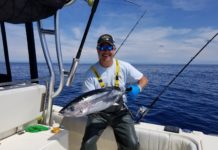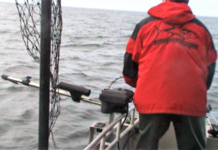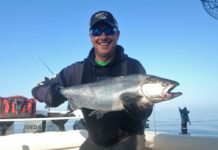
The science team during the Hidden Ocean 2005 expedition to explore remote parts of the Arctic Ocean descends onto the ice below in a man lift. Image courtesy of The Hidden Ocean, Arctic 2005 Exploration.
Did You Know?
Long before changes in the Arctic were garnering regular media headlines, NOAA’s Office of Ocean Exploration and Research (OER) was sponsoring scientists in the collection of baseline data about marine life in sea ice, in the water column, and on the sea floor, as well as geological and morphological seafloor data in the ice-covered Arctic.
For example, OER partnered with Canada, Japan, and China in 2002 to initiate biodiversity assessment of the high-Arctic’s Canada Basin from the sea ice down to the sea floor. And since 2004, OER has regularly co-sponsored the Russian-American Long-Term Census of the Arctic expedition with the NOAA Arctic Research Office to explore the Arctic’s deep Canada Basin and other areas, to monitor fresh and salt water flux, and to build an inventory of marine life distribution and migration patterns related to global climate change.
The Arctic Ocean is the most inaccessible and least-studied of all the Earth’s major ocean basins. Although it is the smallest of these basins, the Arctic Ocean has a total area of about 5.4 million square miles (14 million square kilometers); roughly 1.5 times the size of the United States.
The deepest parts of the Arctic Ocean (17,850 feet; 5,441 meters), known as the Canada Basin, are particularly isolated and unexplored because of year-round ice cover. To a large extent, the Canada Basin is also geographically isolated by the largest continental shelf of any ocean basin. The Chukchi Sea provides a connection between the Canada Basin and the Pacific Ocean via the Bering Strait. However, this connection is very narrow and shallow, meaning that it is likely that unique species have evolved in the mostly isolated Canada Basin. The Bering Strait acts as the only Pacific “gateway” into and out of the Arctic Ocean, meaning it is critical for the flux of heat between the Arctic and the rest of the world.
Exploration of the Arctic Ocean has become increasingly urgent because the Arctic environment is changing at a dramatic rate. Scientific communities now generally agree that the Arctic is in need of additional measurements and observations to accurately monitor and predict future changes. Arctic sea ice cover extent has decreased by about three percent per decade over the last 25 years and observations from submarines indicate a loss in ice thickness in all parts of the Arctic. Climate models predict that Arctic summer sea ice cover might be lost by 2100, which would turn the Arctic Ocean into an ice-free ocean for several months per year.
Obviously, one visible result of changes in the Arctic is the rapid loss of glaciers and sea ice. Less visible are the impacts on living organisms that depend upon glaciers and sea ice for their habitat. Loss of these habitats can also have direct effects on human communities. The Bering and Chukchi Seas and associated marine life are thought to be particularly sensitive to global climate change because these seas are places where steep temperature, salinity, and nutrient gradients in the ocean meet equally steep temperature gradients in the atmosphere.
For More Information:
Russian-U.S. Arctic Census 2012
Russian-U.S. Arctic Census 2009
Three Cold Realms (pdf, 158 kb), The Hidden Ocean Arctic 2005
Arctic Sea Ice, The Hidden Ocean Arctic 2005
Russian-U.S. Arctic Census 2004
Sign up for the Ocean Explorer E-mail Update List.














